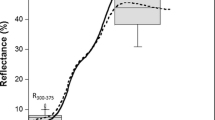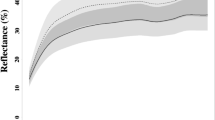Abstract
Commonly, female birds use the brightly coloured patches on males to choose the best-quality mates. Coloured wing patches, however, have received little attention or have been previously related to social behaviour (as a signal to recruit conspecific individuals at feeding patches) or foraging (to flush prey) contexts, rather than to sexual selection. Here we provide evidence that in siskins (Carduelis spinus), wing patches function in mate choice. Mate-choice experiments showed that females were attracted by the size of the yellow wing stripe of the male, but not by the size of its black bib, body size, general plumage brightness or age. Experiments on birds with manipulated yellow wing stripes showed that females were sensitive to the size of this colour patch, irrespective of other male qualities. The preference of female siskins for males with larger wing patches when searching for a mate may be explained by the relationship of this trait to foraging ability, which would ensure females good parental investment from the chosen male.


Similar content being viewed by others
References
Andersson M (1994) Sexual selection. Princeton University Press, Princeton, NJ
Badyaev AV, Hill GE, Dunn PO, Glen JC (2001) Plumage color as a composite trait: development and functional integration of sexual ornamentation. Am Nat 158:221–235
Beauchamp G, Heeb P (2001) Social foraging and the evolution of white plumage. Evol Ecol Res 3:703–720
Berglund A, Bisazza A, Pilastro A (1996) Armaments and ornaments: an evolutionary explanation of traits of dual utility. Biol J Linn Soc 58:385–399
Brooke MdL (1998) Ecological factors influencing the occurrence of ‘flash marks’ in wading birds. Funct Ecol 12:339–346
Burley N, Krantzberg G, Radman P (1982) Influence of colour-banding on the conspecific preferences of zebra finches. Anim Behav 30:444–455
Burtt EH, Swanson JA, Porter BA, Waterhouse SM (1994) Wing-flashing in mockingbirds of the Galápagos Islands. Wilson Bull 106:559–562
Conover WJ (1981) Rank transformations as a bridge between parametric and nonparametric statistics. Am Stat 35:124–129
Espmark YO, Amundsen T, Rosenqvist G (2000) Animal signals. Signalling and signal design in animal communication. Tapir, Trondheim
Figuerola J, Pascual J, Senar JC (1999) The use of a colorimeter in field studies of blue tit Parus caeruleus coloration. Ardea 87:269–275
González G, Sorci G, Møller AP, Ninni P, Haussy C, De Lope F (1999) Immunocompetence and condition-dependent sexual advertisement in male house sparrows (Passer domesticus). J Anim Ecol 68:1225–1234
Gustafsson L, Qvarnström A, Sheldon BC (1995) Trade-offs between life-history traits and a secondary sexual character in male collared flycatchers. Nature 375:311–313
Hailman JP (1960) A field study of the mockingbird’s wing-flashing behavior and its association with foraging. Wilson Bull 72:346–357
Hill GE (1990) Female house finches prefer colourful males: sexual selection for a condition-dependent trait. Anim Behav 40:563–572
Hill GE (1996) Redness as a measure of the production cost of ornamental coloration. Ethol Ecol Evol 8:157–175
Hill GE (1998) Plumage redness and pigment symmetry in the house finch. J Avian Biol 29:86–92
Hill GE (2002) A red bird in a brown bag. Oxford University Press, Oxford
Houde AE (1997) Sex, color, and mate choice in guppies. Princeton University Press, Princeton, NJ
Jablonski P (1996) Dark habitats and bright birds: warblers may use wing patches to flush prey. Oikos 75:350–352
Kokko H (1997) Evolutionarily stable strategies of age-dependent sexual advertisement. Behav Ecol Sociobiol 41:99–107
Kokko H, Lindstrom J (1996) Evolution of female preference for old mates. Proc R Soc Lond B 263:1533–1538
Lifjeld JT, Slagsvold T (1988) Female pied flycatchers choose male characteristics in homogeneous habitats. Behav Ecol Sociobiol 22:27–36
Martin A (1994) A key to ageing siskins. Ringers Bull 8:76–77
Mateos C, Carranza J (1999) Effects of male dominance and courtship display on female choice in the ring-necked pheasant. Behav Ecol Sociobiol 45:235–244
Minolta (1994) Precise color communication: color control from feeling to instrumentation. Minolta, Osaka
Møller AP (1989) Natural and sexual selection on a plumage signal of status and on morphology in house sparrows, Passer domesticus. J Evol Biol 2:125–140
Møller AP (1990) Sexual behaviour is related to badge size in the house sparrow Passer domesticus. Behav Ecol Sociobiol 27:23–29
Møller AP (1994) Sexual selection and the barn swallow. Oxford University Press, Oxford
Møller AP, Kimball RT, Erritzoe J (1996) Sexual ornamentation, condition, and immune defence in the house sparrow Passer domesticus. Behav Ecol Sociobiol 39:317–322
Møller AP, Biard C, Blount JD, Houston DC, Ninni P, Saino N, Surai PF (2000) Carotenoid-dependent signals: indicators of foraging efficiency, immunocompetence or detoxification ability? Avian Poult Biol Rev 11:137–159
Neave HR, Worthington PL (1992) Distribution-free tests. Routledge, London
Newton I (1972) Finches. Collins, London
Pryke SR, Andersson S, Lawes M (2001) Sexual selection of multiple handicaps in the red-collared widowbird: female choice of tail length but not carotenoid display. Evolution 55:1452–1463
Qvarnström A, Forsgren E (1998) Should females prefer dominant males? Trend Ecol Evol 13:498–501
Qvarnström A, Pärt T, Sheldon BC (2000) Adaptive plasticity in mate preference linked to differences in reproductive effort. Nature 405:344–347
Ripoll J, Saldaña J, Senar JC (2004) Evolutionary stable transition rates in a stage-structured model. An application to the analysis of size distributions of badges of social status. Math Biosci 190:145–181
Rohwer SA (1982) The evolution of reliable and unreliable badges of fighting ability. Am Zool 22:531–546
Rohwer SA, Ewald PW (1981) The cost of dominance and advantage of subordination in a badge signaling system. Evolution 35:441–454
Ryan MJ (1997) Sexual selection and mate choice. In: Krebs JR, Davies NB (eds) Behavioural ecology: an evolutionary approach. Blackwell, Oxford, pp 179–202
Saetre GP, Dale S, Slagsvold T (1994) Female pied flycatchers prefer brightly coloured males. Anim Behav 48:1407–1416
Senar JC (1999) Plumage coloration as a signal of social status. In: Adams N, Slotow R (eds) Proc 22 Int Ornithol Congr, Durban. BirdLife South Africa, Johannesburg, pp 1669–1686
Senar JC, Camerino M (1998) Status signalling and the ability to recognize dominants: an experiment with siskins (Carduelis spinus). Proc R Soc Lond B 265:1515–1520
Senar JC, Escobar D (2002) Carotenoid derived plumage coloration in the siskin Carduelis spinus is related to foraging ability. Avian Sci 2:19–24
Senar JC, Pascual J (1997) Keel and tarsus length may provide a good predictor of avian body size. Ardea 85:269–274
Senar JC, Camerino M, Metcalfe NB (1990) Familiarity breeds tolerance: the development of social stability in flocking siskins (Carduelis spinus). Ethology 85:13–24
Senar JC, Camerino M, Copete JL, Metcalfe NB (1993) Variation in black bib of the Eurasian siskin (Carduelis spinus) and its role as a reliable badge of dominance. Auk 110:924–927
Senar JC, Figuerola J, Pascual J (2002) Brighter yellow blue tits make better parents. Proc R Soc Lond B 269:257–261
Sheldon BC, Merilä J, Qvarnström A, Gustafsson L, Ellegren H (1997) Paternal genetic contribution to offspring condition predicted by size of male secondary sexual character. Proc R Soc Lond B 264:297–302
Svensson L (1992) Identification guide to European passerines. Svensson, Stockholm
Tanaka Y (1996) Social selection and the evolution of animal signals. Evolution 50:512–523
Török J, Hegyi G, Garamszegi LZ (2003) Depigmented wing patch size is a condition-dependent indicator of viability in male flycatchers. Behav Ecol 14:382–388
Wolf JB, Brodie ED III, Moore AJ (1999) Interacting phenotypes and the evolutionary process. II. Selection resulting from social interactions. Am Nat 153:254–266
Zahavi A, Zahavi Av (1997) The handicap principle: a missing piece of Darwin’s puzzle. Oxford University Press, New York
Acknowledgements
We would like to thank Lluïsa Arroyo for assistance in the laboratory and for reviewing the paper, Fernando Senar for designing and building the experimental cage, and David Boné and Ester Vilamajor for field assistance. We also thank William A. Searcy and two anonymous referees for helpful suggestions on the paper, Tony Mainwood for early discussions on the possible importance of the siskin yellow wing stripe, and Peter Hörak for discussions on an earlier version of the paper. Birds were captured and kept in captivity with permission of the Subdirecció General de Conservació de la Natura, Departament de Medi Ambient, Generalitat de Catalunya. This work was funded by BOS 2003-09589 research project from the Spanish Research Council, Ministerio de Ciéncia y Tecnología.
Author information
Authors and Affiliations
Corresponding author
Additional information
Communicated by W.A. Searcy
Rights and permissions
About this article
Cite this article
Senar, J.C., Domènech, J. & Camerino, M. Female siskins choose mates by the size of the yellow wing stripe. Behav Ecol Sociobiol 57, 465–469 (2005). https://doi.org/10.1007/s00265-004-0873-7
Received:
Revised:
Accepted:
Published:
Issue Date:
DOI: https://doi.org/10.1007/s00265-004-0873-7




